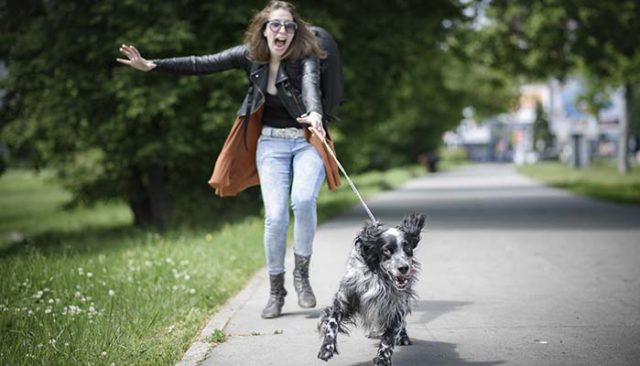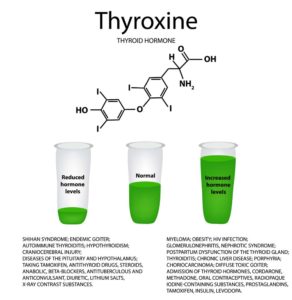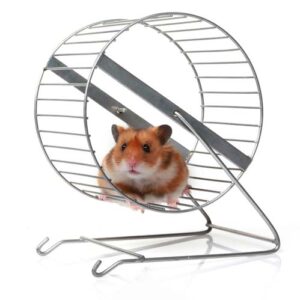
Table of Contents
Y
ou've adopted a dog without completely understanding what you were getting into.
Maybe you did the research and adopted a breed that was supposed to be more mellow, but you got the exception to the rule.
Whatever the reason, now you're in the position to understand hyperactive dogs and how to deal with your pup, who just won't calm down.
Luckily, hyperactivity in dogs is a well-researched and understood subject. There are several scientifically proven ways to help your dog calm down.
I'll discuss all the proven methods to deal with
hyperactive dogs and how you can easily do that.
Hyperactivity in dogs
Hyperactivity in dogs (sometimes referred to by scientists as hyperkinesis in dogs and by pet owners as ADHD in
dogs) is characterized by several factors:
- increased heart and respiratory rates
- low (poor) body condition scores
- reactivity and agitation
All stimuli emotionally arouse hyperactive dogs. They remain at a high level of arousal even after removing the stimuli (Luescher, 1993).
Restlessness, constant non-stop movement and panting, frantic abnormal behavior (e.g., the dog chasing his own tail), and unfocused eyes are other prevalent superficial symptoms of dog hyperactivity.
Interestingly, studies found that hyperactive dogs are often more likely to have lower body weight.
We aren't saying it happens more in small dog breeds. We are speaking in all breeds.
A hyperactive dog weighs less than the average weight of that breed.
When decreasing the dog's weight, he's likely to become more hyperactive (McGreevy et al. 2013).
Dealing with hyperactive dogs takes a good understanding of this condition to accurately address the problem.
For example, age is a factor – if you're working with a puppy, you'll need to give him more time than when dealing with an adult dog.
Most puppies seem to have endless energy, but as they mature, they will likely settle down (Stone et al., 2016).
Some breeds, however, continue to stay hyper well into their adult years.
It's important to note that “puppy tests” for behavioral issues are seldom accurate.
This is because studies found that hyperactive dogs at their early age may not be hyperactive as they age. Most personality disorders in dogs, including hyperactivity, are not accurate indicators of subsequent behavior in older dogs (Fratkin et al., 2013).
Owner report studies found that most working breeds are the least likely to be among hyperactive dogs, though there are exceptions (Tonoike et al., 2015; Lit et al., 2010).
This makes sense for owners who put working breeds to work instead of neglecting their needs.
Other reports found that the most hyperactive dog breeds tend to be:
- Jack Russell Terrier
- Border Collie
- English Pointer
- Husky
- Chihuahua
- Labrador Retriever
Many breeds have been tested for hyperactivity, both AKC-recognized and non-AKC-recognized breeds.
However, the studies lack consistency.
There doesn't seem to be convincing evidence that specific breeds are genetically predisposed to suffer from hyperactivity (aside from a few known breeds, like Jack Russell Terrier).
Why you must address the hyperactivity issue
Hyperactive dogs are not just an inconvenience for a dog owner. There are several good reasons why you must find ways to deal with this problem before it's too late.
For example, reports show hyperactive dogs are likely to express impulsive behavior (Riemer et al., 2014; Wright et al., 2012).
Similar to ADHD in humans, impulsivity in dogs is caused by poor hormonal regulation in the body and primarily due to low levels of dopamine and serotonin.
This resulted in a close correlation between canine aggression and impulsivity in dogs.
Studies have confirmed that impulsive and hyperactive dogs are more likely to be aggressive (Amat et al., 2009; Peremans et al., 2003).
Other than aggression, hyperactivity in dogs is the cause of many other severe behavioral problems.
In fact, it's one of the main reasons why pet owners give up on their dogs.
Research demonstrated that impulsive and hyperactive dogs are significantly more likely to be relinquished by pet owners due to a variety of said behavioral problems caused by this condition (Salman et al., 2010; Stephen et al., 2007; Kobelt et al., 2003).
If you're dealing with hyperactive dogs in your household, there are many things that you can do.
Today we'll go through different ways to make the situation easier or solve the whole problem altogether.
Of course, if you're really concerned about your dog's well-being, speak with your veterinarian and canine behaviorist.
ALSO READ: 12 Tips on How to Mentally Stimulate a Dog (Based on Science)
8 Evidence-based Ways to Deal with Hyperactive Dogs
Amend Your Dog's Diet
Protein is crucial in a dog's diet because it contains the amino acids to build muscles and tissues.
However, too much protein in the diet can provide excess energy, especially if your dog consumes more power than he is expending (Young, 1991).
Since dog owners are more likely to focus on feeding meat to their dogs, it's easy to overestimate the amounts and overfeed the dog, particularly on a homemade diet.
The research found a correlation between high protein diets and aggression in dogs stemming from hyperactive behavior (DeNapoli et al. 2000).
This study included 11 dogs with dominance aggression, 11 with territorial aggression, and 11 with hyperactivity.
High protein and low protein diets were compared for each group of dogs.
It was shown that adding tryptophan to the dog's diet or decreasing protein levels in the diet helps reduce aggression and hyperactivity in dogs.
Why does more protein = aggression and hyperactivity in dogs?
A potential link between high protein diets and aggressive behavior is ammonia concentrations in the blood.
Ammonia is a waste product of protein metabolism, and the presence of ammonia indicates a lower digestible protein (Foster et al. 1938; Gibson et al. 1976).
According to this Orijen White Paper (PDF), dogs fed diets containing highly digestible and concentrated proteins showed less aggression and hyperactivity than dogs fed low-quality protein.
In summary, amending your dog's diet can help to decrease hyperactivity and aggression.
To get the most out of your dog's diet:
- Feed your dog the correct daily allowances for his/her weight to make sure that energy intake does not exceed what is required, even if it's coming from protein;
- Ensure that the ingredients are easily digested and metabolized by your dog;
- Prioritize high-quality protein sources, preferably animal-based;
- Feed dog food appropriate to your dog's age and activity level.
According to the above study, you can also prioritize food sources higher in tryptophan. Make sure they are safe for dogs and non-toxic.
Some dog-friendly foods high to moderate in tryptophan are poultry (turkey in particular), red meats, cottage cheese, buckwheat, eggs, yogurt, fish, and pumpkin seeds.
Researchers also found that a ketogenic diet can help with hyperactivity disorder and other ADHD symptoms in dogs (Packer et al., 2016).
This study found a correlation between epilepsy and hyperactive dogs, and the ketogenic medium chain triglyceride diet (MCTD) helped relieve many ADHD-like symptoms in dogs.
That said, it's essential to discuss this with your vet before you put your dog on a keto diet like this.
A Keto diet for dogs may help with hyperactivity and ADHD symptoms. Still, it might have detrimental effects on your pup in other areas.
Thyroid Treatments
Hyperactive dogs that express poor behavioral habits are also somewhat likely to have an underlying medical reason.
The two most common medical problems are an overactive thyroid or other thyroid dysfunctions.
This paper (PDF) and several mentioned studies found thyroid dysfunction in animals to be associated with several clinical signs, including an erratic temperament, periods of hyperactivity, and anxiety.
Other signs include moodiness, general ADHD and compulsive behavior, and irritability (Bezzola, 2002).
This is not surprising because hypothyroidism has been associated with many cases of ADHD in people, particularly children (Rovet et al. 1996).
For example, children with high levels of thyroid hormones exhibited a high level of distractibility and had a lower attention span.
Similarly, rats with overactive thyroids exhibited abnormal behaviors.
The abnormal behavior was higher levels of locomotion and a lower rate of correct avoidance responses, an indication of ADHD.
Available thyroid treatments for dogs
Several thyroid treatments for dogs are proven effective for dogs with an overactive thyroid, which is associated with hyperactive dogs.
You must discuss this with your veterinarian to find the most appropriate treatment.
For example, thyroxin (or Levothyroxine) is a drug to help hyperactive dogs by treating overactive thyroids (if that is the actual cause of hyperactivity in your pup).
In some studies, treatment with thyroxin suppresses thyroid hormone production in Beagle dogs with hypothyroidism (Panciera et al. 1990).
Several different thyroxin brands are available, including Levothroid, Levoxyl, Synthroid, Tirosint, and Unithroid.
Amphetamines
Amphetamines are central nervous system stimulants used to treat ADHD in dogs and humans.
These drugs are most famous for people with various conditions but were previously used to successfully help hyperactive dogs too.
Obviously, do not give your pet amphetamines without prior consultation with a veterinarian.
In one study, Beagle dogs with a dose of 0.2 mg/kg amphetamines (dextroamphetamine) were observed to determine behavioral and physiological changes.
The changes observed were body temperature, heart rate, and motor activity.
Oral amphetamines resulted in a calming effect, as seen with a decrease in motor activity, with a greater than 15% reduction in heart rate (Stiles et al. 2011).
Amphetamines may work in treating ADHD in dogs even though they are considered stimulants.
Amphetamines stimulate and increase the release of certain chemicals in the brain, particularly dopamine and norepinephrine (Hodgkins et al., 2012).
In healthy functioning dogs, those two brain chemicals are what urge a dog to pursue a goal/outcome: food, sex, play, and smells.
And as the studies mentioned above showed, these are two main contributors to overly hyper dogs.
So, giving your dog amphetamines may improve the transmission and receipt of messages within the dog's brain and calm the dog down.
RELATED: 5 Ways To Train A Hyperactive Dog To Calm Down
L-tyrosine Supplementation
Tyrosine is a precursor to the neurotransmitter dopamine in the dog's brain.
Abnormalities in dopamine neurotransmission are believed to be connected to symptoms of ADHD in dogs.
This includes behaviors like inattention and impulsivity.
Both of which I've mentioned by going over the above studies with hyperactive dogs.
Further evidence suggests that ADHD is associated with fronto-cortical dysfunction.
The fronto-cortical area of the brain is rich in dopamine (Genro et al., 2014).
Previous research tentatively suggested that the D4 dopamine receptor gene, the dopamine transporter gene, and the D2 receptor gene are directly involved in the clinical symptoms of ADHD (Faraone et al. 1998).
For example, Roborovskii hamsters are characterized by low levels of dopamine in the brain and high levels of locomotor activity (an indication of hyperactivity disorder) compared to other hamsters.
In this one experiment, chronic supplementation of L-tyrosine decreased the locomotor activity of the Roborovskii hamsters in the home cage (Hodgkins et al., 2012).
In addition, tyrosine increased the turnover rates of dopamine and norepinephrine and decreased the serotonin turnover rate in the brain.
Even more studies with animals on the role of L-tyrosine in alleviating hyperactivity are available.
“Manic” activity, such as hyperactivity and repetitive movements involving the whole body in rodents, was blocked with treatment with alpha-methyl-para-tyrosine (Davies et al. 1976).
This shows that L-tyrosine supplementation is a viable treatment for hyperactivity in rodents.
There's a good chance it will have similar effects on hyperactive dogs.
Exercise
Exercise should be the first of the tools in treating hyperactive dogs.
Plenty of exercises can eliminate any pent-up energy, alleviate your dog's boredom, and provide many health benefits.
While there are no studies directly correlating studies of exercising and relief for ADHD in dogs, several mentioned above imply this to be the case.
Moreover, studies on 8-12-year-old children showed that maximal treadmill walking decreased motor persistence and eye blink rate, indicators of ADHD behavior (Tantillo et al. 2002).
In an animal model, treadmill exercise improved hyperactivity disorder symptoms, including an improvement in spatial learning memory (Kim et al. 2011).
They had rats with ADHD exercise.
The result was an increase in the expression of tyrosine hydroxylase (TH) and brain-derived neurotrophic factor (BDNF).
Both are assumed to alleviate ADHD symptoms.
Another study provides evidence that treadmill exercise reduces the symptoms of ADHD.
It reduces the cell loss of Purkinje cells and astrocytes in the cerebellum.
Purkinje cells are essential for dogs as they regulate and coordinate motor movements.
Astrocytes help modulate circulation and blood flow and transport mitochondria to neurons.
Basically, both work to keep the dog's body and brain functioning properly, have energy when it's time to play, and rest when it's time to sleep.
With everything we know today about exercising hyperactive dogs, it's safe to assume it will likely relieve dogs' ADHD symptoms and calm your pup.
Exercise can also help to utilize extra calories and energy from the diet.
Other than taking your dog for long walks, some other good exercises for hyperactive dogs include running, swimming, and Frisbee.
Playing Classical Music
Classical music can have a calming effect on hyperactive dogs, as demonstrated in several studies and discussed in more detail in Mary's article on calming dogs (Meade et al. 2016).
Playing music is LIKELY to reduce heart rate variability in your dog.
In mice, music treatment decreased anxiety states and may provide a practical therapeutic effect on anxiety (Wen-Jing et al., 2009).
According to the Institute of Education Sciences, children exposed to classical music in the background during study sessions had better recall of sounds and names.
These same kids also had better focus and attention [source].
Check out this article that discusses a similar effect on calming music for dogs.
In rats, Mozart's music was shown to increase dopamine synthesis in the brain, which leads to a reduction in blood pressure (Akiyama et al. 2011).
More specifically, music with higher frequency sounds, such as 4k-16k Hz, resulting in more remarkable dopamine synthesis than low-frequency sounds, which are likely to calm the animal.
As noted earlier, abnormalities in the dopaminergic system are involved in ADHD. They are likely to be one of the critical causes of ADHD in dogs.
Studies show in animal models that musical stimuli affect the autonomic system.
Musical stimuli seem to have neurochemical effects as well.
They may also modify synaptic plasticity (Rickard et al. 2005).
Classical music can also help with relaxation and increase quiet time for the dog.
In contrast, and not surprisingly, heavy metal music encourages dogs to spend more time barking, as demonstrated in one study (Wells et al. 2002).
Castration
Testosterone is likely to be one of the significant contributors to hyperactive dogs.
Studies have long concluded that male dogs are typically more hyperactive and aggressive than females.
There is a lot of data on this, and too much to plow through for this article.
For example, a statistic on dog-bite fatalities between 1989 and 1994 shows that 19 of 20 deaths involved an unneutered dog (Sacks et al. 1996).
Unneutered puppies and kittens appear more aggressive and hyperactive than neutered animals (Lieberman, 1987).
This is because unneutered animals still have testicles, which can continue producing high testosterone concentrations.
Testosterone production can lead to higher levels of aggression and behavior problems in animals, including mounting and roaming.
Studies on testosterone show that increased testosterone levels can stimulate parts of the brain involved in threat-processing and aggressive behavior.
Specifically, in overly hyper dogs, aggression and fighting between males decreased with neutering or progesterone treatment (Knol et al. 2011).
In another study with chimpanzees, increased aggression levels were seen when testosterone levels were high (Muller et al. 2004).
Teach Hyperactive Dogs New Tricks
Learning a new trick can help calm your dog's nerves and mentally challenge hyperactive dogs.
This is because occupying your pet's brain with a new challenge is likely to concentrate his energy on that task rather than expend it in other ways.
Learning new dog training tricks can help your dog remain focused on a task, as well as help build a common language and trust between the master and his/her dog.
Studies on dogs show that playing games and learning new tricks reduced behavioral issues, including anxiety, whining, and aggression.
Training a dog can help to set boundaries for your Fido, including what behaviors are acceptable or unacceptable.
For example, trick training can help control a dog that may bark or jump too much.
Many dismiss hyperactive dogs, saying that “it is just a dog being a dog.”
Sadly, the truth may develop other unwanted behaviors and could also be a sign of other underlying health problems.
Learning how to detect and act with hyperactive dogs is critical.
When you can deter the dog from exhibiting undesirable actions such as being aggressive and potentially dangerous.
On top of that, it helps maintain the dogs' physical and mental health.
READ NEXT: 15 Facts About Fear Aggression in Dogs You Must Know



















